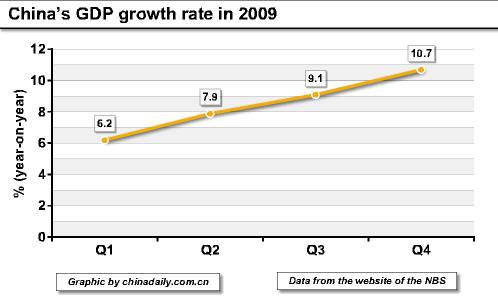
China's economic growth accelerated to 8.7 percent year-on-year in 2009, achieving the full-year growth target of 8 percent and totaling 33.54 trillion yuan ($4.91 trillion), the National Bureau of Statistics (NBS) said Thursday.
The growth rate was 10.7 percent year-on-year in the fourth quarter.
The GDP growth rate for the first quarter was revised to 6.2 percent, from 6.1 percent and that for the third quarter was revised to 9.1 percent, from 8.9 percent and that for the second quarter stays unchanged, 7.9 percent, the NBS said.
According to the NBS, in 2009, the value-added of the primary sector topped 3.55 trillion yuan, up 4.2 percent from a year earlier; that of the industrial sector stood at 15.70 trillion yuan, up 9.5 percent year-on-year; and the tertiary sector, the service sector, reported value-added totaling 14.29 trillion yuan, up 8.9 percent.
"Last year is the most difficult one for China's economy in the new century,"said Ma Jiantang,director of the National Bureau of Statistics (NBS). "Thanks to government's efforts to deal with various difficulties, the country's economy ended accelerating slide and began to recover as a whole."
Ma attributed the recovery mainly to the implementation of the proactive fiscal policy and moderately loose monetary policy, as well as the stimulus package adopted by the government to cope with the global financial crisis.
He described the country's economic development last year as a "harvest", saying the newly released figures confirmed a V-shaped recovery of the economy from the world economic downturn.
Since November 2008, the Chinese government has adopted a series of stimulus measures including a 4-trillion yuan investment package, tax cuts, and consumer subsidies to shore up growth and employment.
As an important component of the stimulus package, the country also launched revitalization scheme for 10 major industries, including steel, car making, textile and machinery, to which the government devoted huge investments.
The country also put forward preferential policies to encourage sales of home appliance, cars and motorbikes in rural areas. More government investment came to infrastructure, scientific research and public service.
Meanwhile, the government shifted from a tight monetary policy in 2008 to the moderately easy monetary policy in 2009 to help the national economy counter adverse impacts of the financial crisis.
Figures from the People's Bank of China, or the central bank, showed that China's new yuan-denominated lending last year hit a record 9.59 trillion yuan, nearly double that of the previous year.
As the stimulus package conducive for the recovery of the economy.China's valued-added of industry rose 11 percent in 2009 from a year earlier. Retail sales rose 16.9 percent year-on-year, while fixed-asset investment rose 30.1 percent.
Ma didn't tell respective contribution percentage of the export, consumption, and investment to the GDP growth due to some statistics reasons, but promised to disclose the figure at the end of the month.
With a consolidated economic recovery, the country began to enter on improving economic growth pattern to achieve an economy with high quality and sustainable growth.
Yu Yongding, a research fellow with Chinese Academy of Social Sciences told Xinhua that the government's stimulus package was a success in "risk control". But some measures did not serve a balanced economy. "The government should focus more on structure adjustment."
Zhang Liqun, a researcher with the Development Research Center of the State Council, echoed Yu, by saying heavy investment and strong consumption had driven the economic growth to accelerate quarter on quarter last year.
"The country needs to seek balanced development pattern to seek sustainable development," Zhang said.
At the Central Economic Work Conference held in December, the government vowed to focus on expanding domestic consumption, supporting agriculture, and improving people's life in 2010.
When asked whether the government would quit the stimulus package, or to introduce more stimulus plans, Ma said, "A key point of macro-regulation this year would be to balance the tasks of ensuring stable and relatively fast economic growth, adjusting economic structure and regulating inflation prospects."
Ma expected stable and relatively fast development of China's economic in 2010, due to the facts that world economy environment would turn better amid a slow recovery, and the domestic investment and consumption were expected to maintain the increasing momentum.
"More over, export and import in 2010 would shift from a decreasing momentum to contribute to the growth of the economy," Ma said.
The NBS figures showed, China's foreign trade totaled $2.2 trillion in 2009, down 13.9 percent from a year earlier. But it began to increase since November, when the monthly figure rose 9.8 percent from a year earlier.





